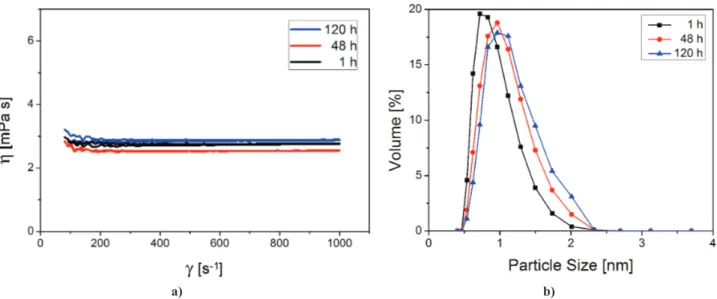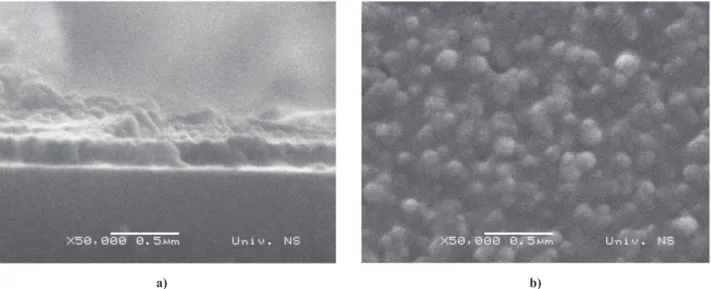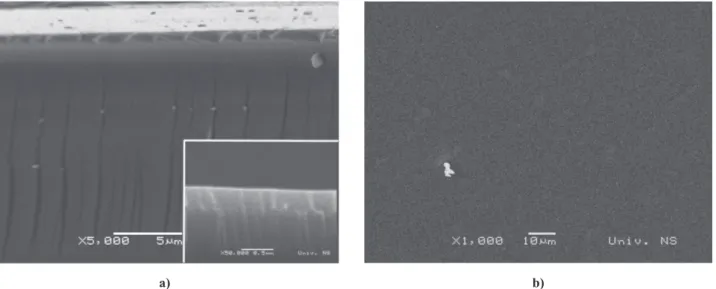Synthesis and characterization of multilayered BaTiO
3/NiFe
2O
4thin
ilms
Branimir Bajac
*, Jelena Vukmirović, Ivan Tokić, Stevan Ognjanović, Vladimir V. Srdić
Department of Materials Engineering, Faculty of Technology, University of Novi Sad, Bul. Cara Lazara 1, 21000 Novi Sad, SerbiaReceived 31 January 2013; received in revised form 14 March 2013; accepted 18 March 2013
Abstract
Presented research was focused on the fabrication of multiferroic thin ilm structures, composed of ferrielectric barium titanate perovskite phase and magnetostrictive nickel ferrite spinel phase. The applicability of differ-ent, solution based, deposition techniques (ilm growth from solution, dip coating and spin coating) for the fabrication of multilayered BaTiO3 /NiFe2O4 thin ilms was investigated. It was shown that only spin coating produces ilms of desired nanostructure, thickness and smooth and crackfree surfaces.
Keywords: multiferroic ceramics, multilayered BaTiO3 /NiFe2O4 structure, ilm deposition
I. Introduction
Lately, multiferroic materials [1–9] with the coexist-ence of both ferroelectric and ferromagnetic properties are widely investigated due to their potential applications in various microelectronic devices. However, the coexist -ence alone is not enough as a strong coupling interaction between two ferroic orders and, consequently, the pres-ence of the valuable magnetoelectric effect is required [5]. The magnetoelectric effect can be simply deined as the appearance of electric polarization upon subjecting the material to a magnetic ield or, conversely, by the ap -pearance of magnetization upon applying an electric ield. Different single-phase magnetoelectric multiferroic mate-rials have been discovered and widely investigated (such as perovskites BiFeO3 and BiMnO3; hexagonal rare-earth
manganates; Fe3O4 spinel, etc.) but they are all charac -terized by a small magnetoelectric coeficient [7,10–12].
An alternative approach, based on composite materi-als where the magnetoelectric effect arises from the in-teraction of ferroelectric and ferromagnetic phases, has been developed [4–6,8,13]. In those composites, none of the constituent phases has an intrinsic magnetoelec-tric effect, but, due to the interaction of the phases, a very high magnetoelectric coeficient can be obtained [5,7]. The mechanism of the interaction can be de -scribed by the induced deformation of the piezoelectric
(electrostrictive) phase upon applying an external elec-tric ield that is transmitted to the magnetoselec-trictive phase through the shared interface and causes a change in its magnetization (or vice versa) [2,6,14]. Particulate bulk composite materials, consisting of spinel and perovskite phases, have been widely investigated [8,13,15]. This is because both perovskites and spinels have high chemi-cal, thermal and mechanical stabilities and form a lim-ited number of secondary phases when mixed together [6]. However, the corresponding magnetoelectric coefi -cients of the particulate composites are still signiicant -ly lower than the theoretical-ly predicted values. This de -viation is usually caused by processing dificulties such as the achievement of suficient bulk density, good dis -persion of ferrite phase and coherent interfaces, as well as avoiding possible reactions and interfacial diffusion between the perovskite and spinel phases. Multilayered composites with alternating perovskite and ferrite layers can have even higher magnetoelectric coeficient then the particulate composites and are therefore considered as viable alternatives [3,6,16].
Various vapour deposition techniques [17,18] have been used for the preparation of multilayered composite ilms, but solution-based approaches have attracted con -siderable attention in recent years [14,19–21] as they are much cheaper and easily adjustable for different condi-tions. Thus, in this paper we investigated the applicability of different, solution based, deposition techniques for the fabrication of multilayered BaTiO3/NiFe2O4 thin ilms.
* Corresponding author: tel: +381 21 485 3665
B. Bajac et al. / Processing and Application of Ceramics 7 [1] (2013) 15–20
II. Experimental
2.1 Preparation of precursor solutions/sols
Multilayered BaTiO3/NiFe2O4 thin ilms (Fig. 1)
were fabricated by different chemical solution deposi-tion techniques (ilm growth from soludeposi-tion, dip coating and spin coating) on silica-glass substrates.
Two different precursors for the deposition of NiFe2O4 layers were prepared. The irst one, denoted as WF solution, was an aqueous solution containing Fe3+
and Ni2+ ions, prepared in a two-step process proposed
by Yourdkhani et al. [14]. In the irst step FeOOH par -ticles were precipitated from an aqueous solution of Fe(NO)3×9H2O (Fluka, Switzerland) in the presence
of a dilute ammonia solution, and subsequently cen-trifuged, washed and dried. In the second step, the ob -tained FeOOH particles and stoichiometric amount of Ni(NO3)3×9H2O (Fluka, Switzerland) were dissolved
in distilled water with boric acid and an aqueous so-lution containing Fe3+ and Ni2+ ions with Ni2+
concen-tration of 0.5 M was obtained. The second precursor, denoted as MF sol, was prepared by dissolving stoichio-metric amounts of Fe(NO3)3×9H2O and Ni(NO)3×9H2O
in 2-methoxyethanol. After stirring at room tempera -ture for 20 min a clear, brownish precursor sol with Ni2+
concentration of 0.38 M was obtained with pH = 1.5. The precursor sol for the deposition of BaTiO3
lay-ers was prepared by mixing of BaCO3 (Merck,
Ger-many) dissolved in concentrated acetic acid with tet-rabutyl-orthotitanate (Ti(OC4H9)4, Fluka, Switzerland)
at room temperature (sol denoted as AT). After 20 min of stirring at room temperature a clear, colourless pre-cursor sol with concentration of 0.5 M was obtained, with pH = 1.
2.2 Deposition of multilayered thin ilms
Three different deposition techniques were exam -ined: i) ilm growth from solution, ii) dip coating and iii) spin coating. Prior to the ilm deposition, silica-glass substrates were cleaned ultrasonically in acetone, etha-nol and rinsed with de-ionised water.
In the irst set of experiments the aim was to obtain bi-layered structure by growing of NiFe2O4 layer from the WF solution and subsequent deposition of BaTiO3
layer by dip-coating technique (sample G-FT, Table 1). After that the intention was to increase the ilm thick -ness by deposition of new NiFe2O4 and BaTiO3 layers. The previously cleaned silica-glass substrate was sus -pended vertically and kept in the WF solution at 40 °C for periods between 30 and 120 min. The initial pH of the solution was around 4 and decreased slowly over the course of the deposition. The obtained ilm was left to dry in air at 120 °C for 20 min., and after that the BaTiO3 layer was deposited by the dip-coating
tech-nique from the AT sol with the withdrawal speed of 0.12 mm/s. After the deposition, the ilm was dried in an oven at 120 °C and inally slowly heated to 600 °C and annealed for 60 min.
Multilayered BaTiO3/NiFe2O4 thin ilms (with six
and ten layers in total) on silica-glass substrate were prepared by alternate deposition of BaTiO3 and NiFe2O4
layers from the AT and MF sol, respectively. Two differ -ent deposition techniques were used: dip-coating with the withdrawal speed of 0.12 mm/s (sample D-FT, Ta -ble 1) and spin-coating with the speed of 3000 rpm for 30 s (samples S1-FT and S2-FT, Table 1). The spin-coated ilms were subjected to two different drying/con -solidation procedures. For the S1-FT sample every de
-Figure 1. Schematic representation of multilayered BaTiO3/NiFe2O4 thin ilms
Table 1. Experimental conditions for preparation of BaTiO3/NiFe2O4 multilayer ilms
Sample Deposition Final heat
NiFe2O4 layer BaTiO3 layer treatments G-FT Growth + drying(WF + 120 °C) (AT + 120 °C)Dip + drying 500 °C and 600 °C for 1 h
D-FT (MF + 120 °C)Dip + drying (AT + 120 °C)Dip + drying 500 °C and 600 °C for 1 h
S1-FT (MF + 120 °C)Spin + drying (AT + 120 °C)Spin + drying 500 °C and 600 °C for 1 h
posited layer was left to dry in air in an oven at 120 °C before the deposition of the next layer. In the case of the S2-FT sample, drying in an oven was substituted by slowly heating the sample to 500 °C and holding it at that temperature for 5 min. In both cases the layer dep -osition procedure was repeated six or ten times and af-ter that the formed multilayered ilms were annealed at 500 °C and 600 °C for 60 min.
2.3 Characterization of sols and ilms
Viscosity of the precursor sols was measured by a Thermo Haake RS600 viscosimeter. Particle size dis -tributions (by volume) of the precursor sols were mea-sured by dynamic light scattering, DLS (Zetasizer Nano ZS, Malvern Instruments). The phase composition of BaTiO3/NiFe2O4 multilayer ilms was characterized
by X-ray diffraction (X’Pert PRO diffractometer with Cu Kα (1.54184 Å) radiation and an X’Celerator detec -tor) in 2θ range from 10° to 120°. The structure of sur -face and cross section of the prepared thin ilms was ex -amined by scanning electron microscopy, SEM (JEOL JSM-6460LV). The presence of all the ions in the exam
-ined multilayer ilms was conirmed by the EDS analy -sis (Oxford Instruments).
III. Results and discussion
3.1 Characterization of precursor solution/sols
The WF precursor solution, used for the deposition of the NiFe2O4 layers by the growth method, is light green and transparent with the viscosity of 1 mPa∙s re -maining constant for at least 10 days. This solution was not used for the deposition of NiFe2O4 layers by dip and spin coating due to its low viscosity and low surface tension. It was the reason why another ferrite sol (MF) was prepared using 2-metoxyethanol. The MF precur -sor sol is brownish, transparent and stable for at least one week. It underwent a slight change of viscosity (Fig. 2a), and almost insigniicant particle growth upon ageing at room temperature (Fig. 2b).
The titanate, AT, precursor sol, used for the deposi -tion of BaTiO3 layers, is colourless, transparent and
sta-ble for at least one week. Figure 3 illustrates that the viscosity of the AT sol increases slightly which can be
Figure 3. Viscosity (a) and particle size distribution (b) of titanate AT sol Figure 2. Viscosity (a) and particle size distribution (b) of ferrite MF sol
a) a)
B. Bajac et al. / Processing and Application of Ceramics 7 [1] (2013) 15–20
assigned to a small particle growth upon ageing at room temperature. Sols with particles that are stable or grow only slightly during ageing are highly desirable, be-cause rapid particle growth may result in ilm thicken -ing, surface imperfections and increased grain size of the inal ilm.
3.2 Characterization of BaTiO3 /NiFe2O4 multilayer ilms
Growth method – It was observed that deposition
time has a great inluence on the uniformity of the fer -rite layer deposited from the aqueous WF solution by the growth method. For deposition times shorter than 90 min. the obtained layer is not uniform. On the other hand, after 120 min. a uniform ferrite layer with thick -ness of ~200 nm and a relatively rough surface was pre-pared (Fig. 4). Deposition of the second BaTiO3 layer
was successfully performed by dip-coating from the AT sol, however, the third NiFe2O4 layer could not be de-posited by the growth method. The reason was the de -structive behaviour of the aqueous WF ferrite solution
to the previously deposited BaTiO3 layer. The long de
-position time required by this method resulted in the ti-tanate layer being peeled off.
Dip-coating - Multilayered BaTiO3/NiFe2O4 ilms
were successfully deposited by the dip-coating process. The obtained 10 layered ilms have good adherence to the silica-glass substrate, uniform thickness of ~1.5 µm and ine grain structure (Fig. 5a). However, cracks and bubble like bumps can be seen on the ilm surface (Fig. 5b). We assumed that the reason was thickness of more than 1 µm and drying that was too fast. In order to re -duce the thickness of the resulting ilms, spin-coating was introduced.
Spin-coating - SEM micrographs of the ten-layered
BaTiO3/NiFe2O4 ilms deposited by spin-coating indi
-cate that the thickness of fabri-cated ilm was reduced to 400 nm, however the surface imperfection remained. Bubble like bumps can be assigned to the reaction be-tween the deposited NiFe2O4 and BaTiO3 layers, name-Figure 4. Single ferrite layer deposited by the growth method and calcined at 500 °C for 1 h: a) cross section b) and surface
morphology
Figure 5. SEM micrographs of multilayered BaTiO3/NiFe2O4 ilm S1-FT (prepared by spin-coating and drying of every deposited layer): a) cross section and b) surface morphology
a)
a)
b)
ly the precursor sols’ solvents, as they were only dried at 120 °C. Therefore, an additional drying/consolidation procedure was introduced to the fabrication process of the multilayered ilms. In addition to drying the samples in an oven at 120 °C, they were slowly heated to 500 °C and held at that temperature for 5 min. Heating each dried layer to 500 °C ensured that all remaining solvent was evaporated and that the formed layer was complete-ly consolidated. This led to nanostructured thin (Fig. 6a) and crack free ilms (Fig. 6b). The XRD pattern of the BaTiO3/NiFe2O4 ilm, heated for 1 h at 600 °C, is
presented in Fig. 7, and is characterized by very weak peaks. The observed XRD peaks may be assigned to the initial formation of nickel-ferrite phase and perovskite phases and the very ine (nanostructured) nature of the obtained multilayered BaTiO3/NiFe2O4 ilms. Further
-more, preliminary results on phase composition ob-tained by X-ray diffraction of identical ilms on alumi -na substrates, treated at higher temperatures (1000 °C) are consistent with previous assumptions.
IV. Conclusions
Multilayered BaTiO3/NiFe2O4 thin ilms were fab
-ricated by different chemical solution deposition tech-niques (ilm growth from solution, dip coating and spin coating) on silica-glass substrate.With the growth meth-od only bi-layered NiFe2O4/BaTiO3 ilms were success -fully prepared, because of the destructive behaviour of the aqueous ferrite solution to the previously deposited BaTiO3 layer. On the other hand, multilayered BaTiO3/
NiFe2O4 ilms, with six and ten layers in total and con -trollable thickness can be prepared by dip and spin coat-Figure 6. SEM micrographs of multilayered BaTiO3/NiFe2O4 ilm S2-FT (prepared by spin-coating and drying/annealing of
every deposited layer): a) cross section and b) surface morphology
Figure 7. XRD pattern of multilayered BaTiO3/NiFe2O4 ilm S2-FT (prepared by spin-coating and drying/annealing of every deposited layer)
B. Bajac et al. / Processing and Application of Ceramics 7 [1] (2013) 15–20
ing techniques. However, cracks and bubble like bumps were formed on the ilm surface if every deposited lay -er was only dried in air at 120 °C before the deposition of the next layer. Spin coating and heating each dried layer to 500 °C ensured the fabrication of ilms with de -sired nanostructure, thickness of 400 nm and smooth and crackfree surfaces.
Acknowledgements: The research was supported by
the Serbian Ministry of Science under the Project No. III45021. The cooperation under the COST MP0904 Project is also highly acknowledged.
References
1. J. van den Boomgaard, R.A.J. Born, “A sintered mag -netoelectric composite material BaTiO3-Ni(Co,Mn)
Fe3O4”, J. Mater. Sci., 13 (1978) 1538–1548.
2. K.J. Choi, M. Biegalski, Y.L. Li, A. Sharan, J. Schubert, R. Uecker, P. Reiche, Y.B. Chen , X.Q. Pan, V. Gopalan, L.-Q. Chen, D.G. Schlom, C.B. Eom, “Enhancement of ferroelectricity in strained BaTiO3
thin ilms”, Science,306 (2004) 1005–1009.
3. S.X. Dong, J.Y. Zhai, N.G. Wang, F.M. Bai, J.-F. Li, D. Viehland, T.A. Lograsso, “Fe-Ga/Pb(Mg1/3Nb2/3)O3
-PbTiO3 magnetoelectric laminate composites”, Appl.
Phys. Lett., 87 (2005) 222504.
4. L. Mitoseriu, V. Buscaglia, M. Viviani, M.T. Busca -glia, I. Pallecchi, C. Harnagea, A. Testino, V. Treiletti, P. Nanni, A.S. Siri, “BaTiO3-(Ni0.5Zn0.5)Fe2O4
ceram-ic composites with ferroelectrceram-ic and magnetceram-ic proper-ties”, J. Eur. Ceram. Soc., 27 (2007) 4379–4382.
5. J. Zhai, Z. Xing, S. Dong, J. Li, D. Viehland, “Magne -toelectric laminate composites: An overview”, J. Am. Ceram. Soc., 91 [2] (2008) 351–358.
6. C.A.F. Vaz, J. Hoffman, C.H. Ahn, R. Ramesh, “Mag -netoelectric coupling effects in multiferroic complex oxide composite structures”, Adv. Mater., 22 (2010) 2900–2918.
7. J. Ma, J. Hu, Z. Li, C.-W. Nan, “Recent progress in multiferroic magnetoelectric composites: From bulk to thin ilms”, Adv. Mater., 23 (2011) 1062–1087.
8. Q. Jiang, F. Liu, H. Yan, H. Ning, Z. Libor, Q. Zhang, M. Cain, M.J. Reece, “Magneto-electric properties of multiferroic Pb(Zr0.52Ti0.48)O3-NiFe2O4 nanoceramic
composites”, J. Am. Ceram. Soc., 94 [8] (2011) 2311– 2314.
9. B. Fraygola, A.A. Coelho, D. Garcia, J.A. Eiras, “Magnetic and ferroelectric phase coexistence in mul -tiferroic PFW-PT ceramics”, Process. Appl. Ceram., 6
[1] (2012) 65–75.
10. J. Wang, J.B. Neaton, H. Zheng, V. Nagarajan, S.B. Ogale, B. Liu , D. Viehland, V. Vaithyanathan, D.G. Schlom, U.V. Waghmare, N.A. Spaldin, K.M. Rabe, M. Wuttig, R. Ramesh, “Epitaxial BiFeO3
multifer-roic thin ilm heterostructures”, Science, 299 (2003) 1719–1722.
11. G. Catalan , J.F. Scott, “Physics and applications of bismuth ferrite”, Adv. Mater., 21 [24] (2009) 2463– 2485.
12. L. Kozielski, F. Clemens, “Multiferroics application - Magnetic controlled piezoelectric transformer”, Pro-cess. Appl. Ceram., 6 [1] (2012) 15–20.
13. X.-H. Liu, Z. Xu, X.-Y. Wei, Z.-H. Dai, X. Yao, “Fer -roelectric, ferromagnetic, and magnetoelectric char-acteristics of 0.9(0.7BiFeO3-0.3BaTiO3)-0.1CoFe2O4
ceramic composite”, J. Am. Ceram. Soc., 93 [10] (2010) 2975–2977.
14. A. Yourdkhani, A.K. Perez, C. Lin, G. Caruntu, “Mag -netoelectric perovskite-spinel bilayered nanocompos-ites synthesized by liquid-phase deposition”, Chem. Mater., 22 (2010) 6075–6084.
15. L. Mitoseriu, I. Pallecchi, V. Buscaglia, A. Testino, C.E. Ciomaga, A. Stancu, “Magnetic properties of the BaTiO3-(Ni,Zn)Fe2O4 multiferroic composites”, J.
Magn. Magn. Mater., 316 (2007) e603–e606.
16. J.Y. Zhai, N. Cai, Z. Shi, Y. H. Lin, C.-W. Nan, “Coupled magnetodielectric properties of laminated PbZr0.53Ti0.47O3/NiFe2O4 ceramics”, J. Appl. Phys., 95
(2004) 5685.
17. J.H. Li, I. Levin, J. Slutsker, V. Provenzano, P.K. Schenck, R. Ramesh, J. Ouyang, A.L. Roytburd, “Self-assembled multiferroic nanostructures in the CoFe2O4-PbTiO3 system”, Appl. Phys. Lett., 87 (2005) No. 072909.
18. D.G. Schlom, L.Q. Chen, X.Q. Pan, A. Schmehl, M.A. Zurbuchen, “A thin ilm approach to engineer -ing functionality into oxides”, J. Am. Ceram. Soc., 91
[8] (2008) 2429–2454.
19. G. Srinivasan, E.T. Rasmussen, B.J. Levin, R. Hayes, “Magnetoelectric effects in bilayers and multilayers of magnetostrictive and piezoelectric perovskite ox-ides”, Phys. Rev. B, 65 (2002) 134402.
20. S.A. Solopan, O.I. V’yunov, A.G. Belous, A.I. Tovsto -lytkin, L.L. Kovalenko, “Magnetoelectric effect in com -posite structures based on ferroelectric-ferromagnetic perovskites”, J. Eur. Ceram. Soc., 30 (2010) 259–263.
21. X. Tanga, J. Daia, X. Zhua, W. Songa, Y. Sun, “Mag -netic annealing effects on multiferroic BiFeO3



